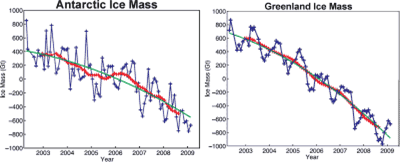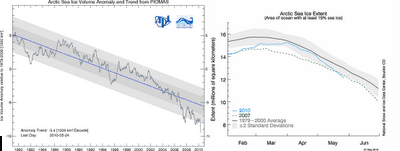In April 2009, The Australian published an article claiming an ice age is imminent, based on the observation that sunspots were few and far between. The article also contains a completely bogus claim that temperatures dropped 0.7°C in 2007. While the temperature drop claim was pure fabrication (or to be charitable, misreading of a data source), the drop in sunspot count is not, and sunspot numbers correlate very well with solar output. We have just emerged from the deepest solar minimum in nearly 100 years so while the ice age story is obviously ridiculous, we should have had near-record lows the last few years instead of temperatures staying close to record highs.
If this is an ice age, where’s the ice going?
More to the point, a project called GRACE (Gravity Recovery and Climate Experiment), which uses satellites to do accurate measurements of changes in mass on the ground, shows changes in the major land-based ice sheets are pointing in the wrong direction. Mass loss is accelerating (Velicogna 2009), hardly indicative of a slide into an ice age:

Advertisement
The graphs show the monthly change in ice mass. Don’t get too excited by the uptick in the last Greenland months; that reflects moving into northern winter. January 2009 had a significant loss of ice over January 2008. The latest GRACE data has not yet been formally published, but the Skeptical Science site has an update that shows the downward trend continuing into 2010.
What of the Arctic? Some have taken comfort in the fact that Arctic sea ice extent (defined as the fraction of the surface with more than 15 per cent ice) hit an all time low in 2007 and bounced back the next couple of years. The trouble is recent measures of Arctic ice volume (Polar Science 2010) show that even if the area covered with ice hasn’t been shrinking, the volume of the ice has. What’s more, the latest measure of sea ice extent (Arctic Sea Ice News & Analysis 2010) has just crossed over the 2007 line (check the latest here):

So if this is an ice age, where’s all the ice going?
The other big issue
Meanwhile the US Gulf oil spill continues almost unabated, more than a month after it started. What this disaster underlines is that more and more often, new oil is going to be found not only in ecologically sensitive situations, but locations where extraction is highly risky. We’ve already seen how hard it is to stop a major leak in the deep ocean. It takes little imagination to see how much harder this would be under Arctic conditions. So drilling for oil in the Arctic has to be considered an extremely high-risk proposition, enthusiasts notwithstanding.
What of alternatives? We’ve known for a long time that oil from coal technology is highly polluting (Chartock et al. 1982), and tar sands are turning out to be even worse (Timoney and Lee (PDF 392KB) 2009).
Advertisement
We are not only facing an end to cheap oil, but we have to face up to the fact that there is no way to replace cheap oil by another fossil fuel without substantial environmental costs. Add to this the fact that these oil substitutes, by virtue of energy-intensive production, contribute much more to CO2 emissions than conventional oil. We are facing a very stark choice:
- carry on as if there is no problem and pay an increasingly unacceptable environmental price; or
- make the search for alternatives a top priority.
Where is this taking us?
Exiting from the solar low will almost certainly take us into rapid temperature rise again. We are already seeing an uptick in the first part of 2010 that has no explanation in natural causes. Had we reacted rationally 20 years ago to the earliest indications that harmful climate change was possible by a gradual phased move away from fossil fuels, we would not have a serious problem today.
Discuss in our Forums
See what other readers are saying about this article!
Click here to read & post comments.
31 posts so far.